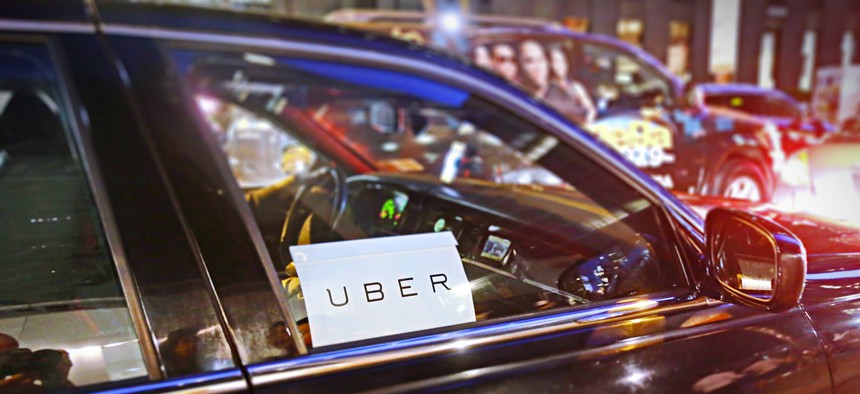Uber Drivers Are Getting Minimum-Wage Protection for the First Time

Shutterstock
New York City's taxi commission voted for a pay floor for ride-hail drivers.
New York City voted Tuesday to enact a first-of-its-kind pay floor for ride-hail drivers, who as independent contractors are not protected by federal or state minimum-wage laws.
The pay standard approved by the city’s Taxi and Limousine Commission aims to raise drivers’ take-home pay to $17.22 an hour, an increase of 44%. The new pay floor, which takes effect in 30 days, could raise annual wages for 70,000 professional drivers in the city by as much as $9,600.
The taxi commission’s actions come amid a devastating string of suicides by professional drivers in New York City. Eight drivers have died by suicide since late 2017: Roy Kim, a yellow cab owner and driver; Fausto Luna, an Uber driver; Abdul Saleh, a yellow cab lease driver; Yu Mein Kenny Chow, a yellow cab owner and driver; Nicanor Ochisor, a yellow taxi owner and driver; Danilo Corporan Castillo, a Bronx livery driver; Alfredo Perez, a Bronx livery driver; and Douglas Schifter, a black-car driver.
A common theme in each case was economic despair and a sense of betrayal by politicians and regulators who allowed the yellow-cab industry to be steamrolled by companies like Uber and Lyft. Castillo wrote his suicide note on the back of a taxi commission summons. Schifter shot himself in front of City Hall.
“This first-time regulation to form a floor for app driver earnings and give a modest first raise is a long time in the making,” Bhairavi Desai, executive director of the pro-driver New York Taxi Workers Alliance said in a statement. ”It’s the first real attempt anywhere to stop app driver pay cuts, which is an Uber and Lyft business practice at the heart of poverty wages.”
The pay standard approved by the commission makes use of a clever formula devised by economists James Parrott and Michael Reich for a July report on driver earnings commissioned by New York City. The key to the formula is an industry-wide “utilization rate” that adjusts the amount drivers are paid per mile and per minute to account for how much work they are getting each hour.
The simple brilliance of the formula is that it puts the burden on ride-hail companies to ensure their drivers are getting enough work. If too many cars are on the road, causing a driver’s utilization rate to fall below the number set by the taxi commission, then companies pay more to make up the difference. (For more on the pay formula, see an explainer from July.)
Uber criticized the taxi commission’s decision to use an industry-wide utilization rate rather than calculating separate rates for each company, warning of “higher than necessary fare increases” for riders. The company said in a statement that the taxi commission also missed a chance to deal with congestion in central Manhattan by rewarding companies that had high utilization rates, i.e. fewer empty cars waiting for passengers and clogging up busy streets.
The expected pay raise for drivers is even more dramatic than the one Parrott and Reich initially calculated after the Independent Drivers Guild and the New York Taxi Workers Alliance successfully lobbied the taxi commission to adjust its expense estimates for drivers, which the groups said were much higher than assumed. The new pay formula also includes “out of town rates” that pay drivers extra for miles they drive outside city limits. The taxi commission also voted to reduce credit card processing fees for yellow and green cabs to $7 per shift from $11.
It’s notable that New York City and its driver advocacy groups have successfully ushered in what promises to be a material improvement to driver livelihood just as other efforts to do the same—a driver union in Seattle, employment classifications lawsuits in the United Kingdom and around the U.S.—remain mired in litigation.
Back in October, a research paper from the Center for Global Development on gig work argued that “the focus should be on improving the working conditions of independent workers… rather than continuing to pretend that regular, formal, contracted employment is the way that people—particularly youth—want (or even should want) to earn a living.”
NYC’s driver pay floor is an embrace of this thinking. Half a decade of arguing over whether Uber drivers should be contractors or employees has done little to improve their lot. These pay rules don’t pretend to answer that question. Instead they ask a more fundamental one—are drivers able to earn a living?—and, having answered it with a resounding no, set about changing the circumstances.
Every city in the U.S. should be watching, and thinking about whether to follow.
Alison Griswold is a reporter for Quartz, which originally published this article

NEXT STORY: D.C. code meets open government on GitHub





